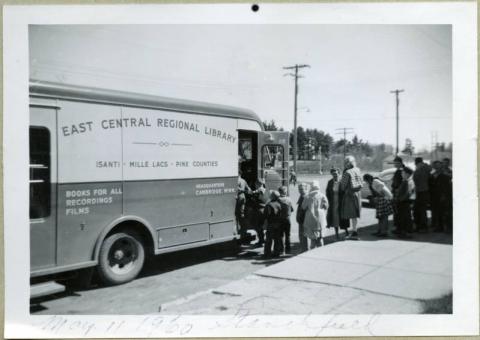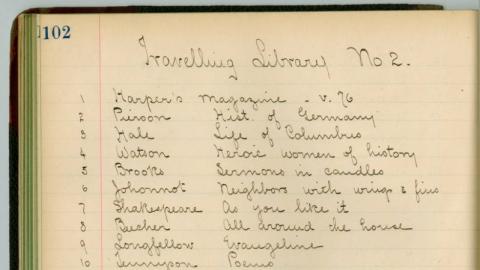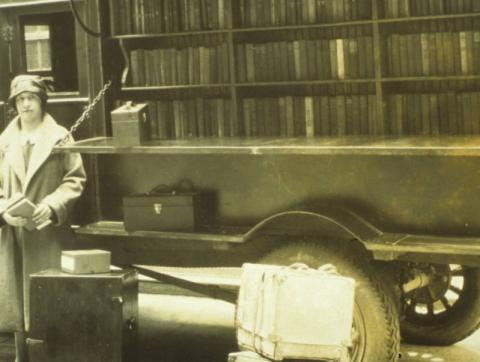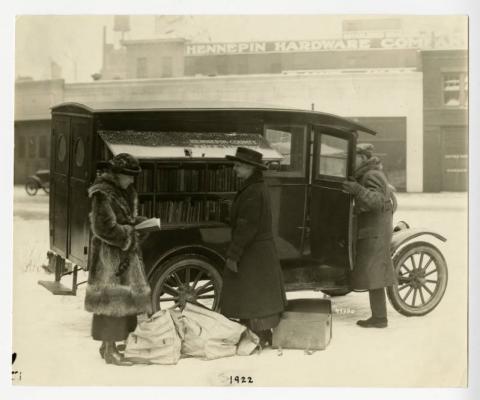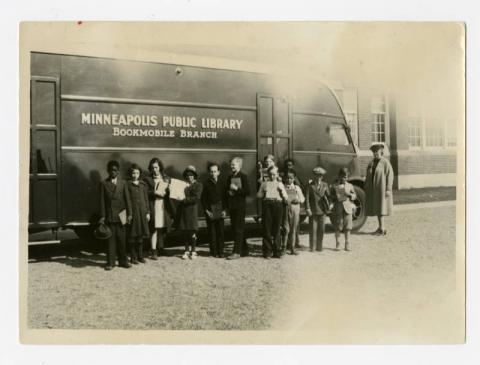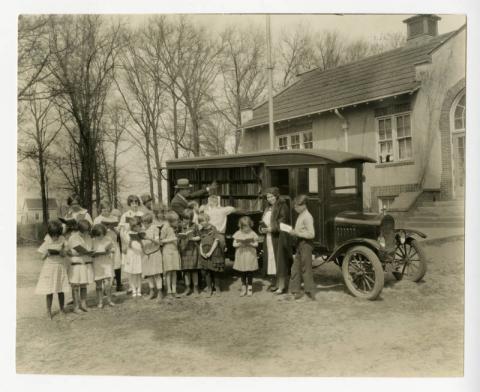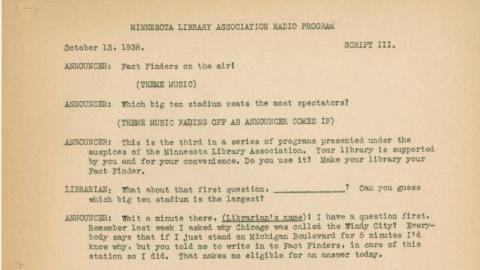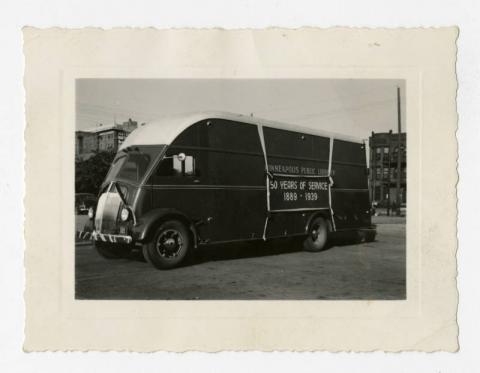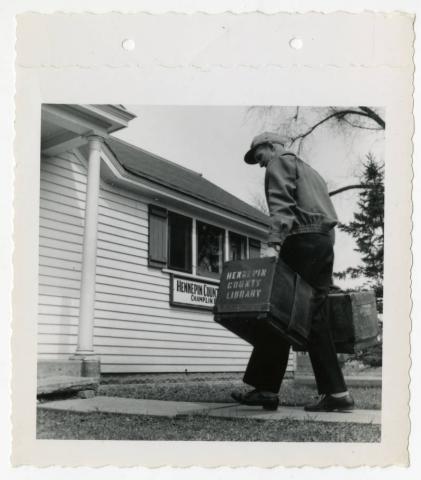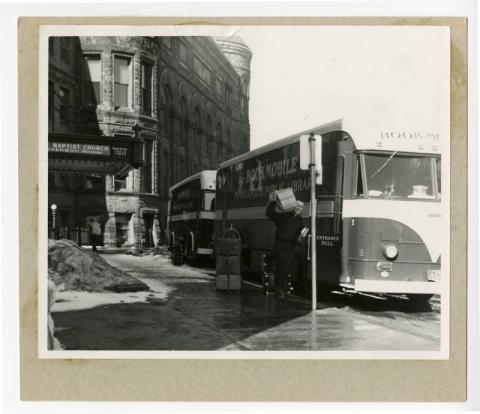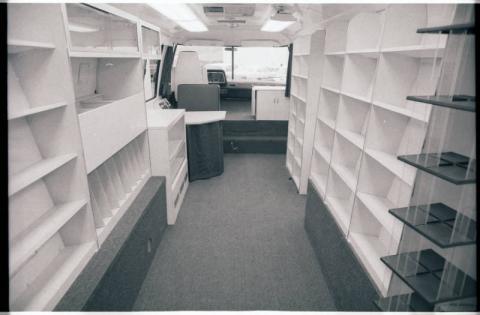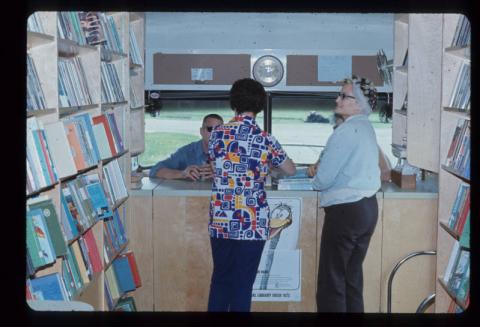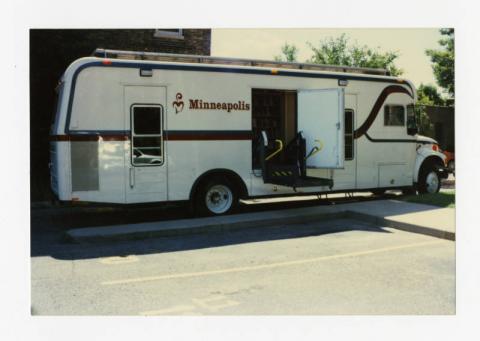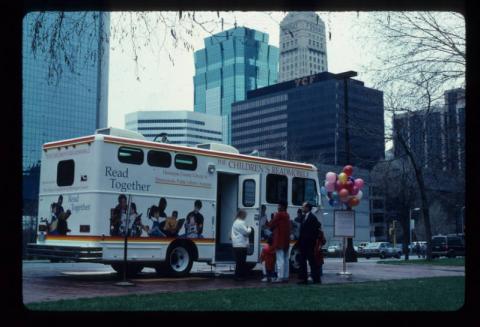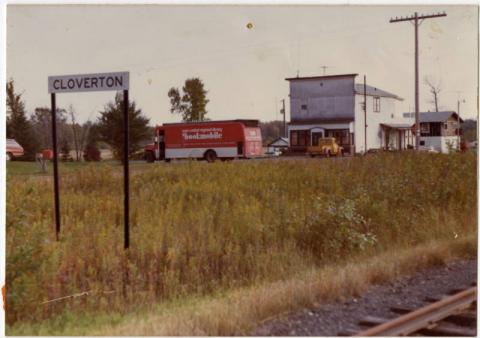Primary Source Set
by Beth Goodrich, Assistant Program Coordinator, Minitex
Mobile library services began in Minnesota in order to fill the reading and information needs of Minnesotans who did not have access to library collections in their communities. These early mobile services were in the form of traveling libraries and book mobiles. Traveling libraries were collections of 25-50 books which could fit in a box and were delivered to communities requesting them for the cost of shipping. The first traveling libraries were organized by private women's clubs. In 1899 the state legislature passed a bill supporting traveling libraries and appointed the State Public Library Commission to take charge of the program. Within the next twenty years the program would own and maintain over 600 traveling libraries.
The first bookmobile appeared in the United States in the form of a horse-drawn cart, probably around 1905. As the automobile was developed, trucks were employed to carry the large collections of books. These early bookmobiles were typically oriented with the shelves and books facing outward for patrons to browse. By mid century bookmobile designs featured shelving on the inside and the vehicles were large enough for patrons to enter. Bookmobile services declined through the 1990s with budget constraints, and the advent of the internet allowed access to mobile library service in new ways. Today there are still hundreds of bookmobiles in operation in the United States, some offering access to technologies in addition to traditional print resources.
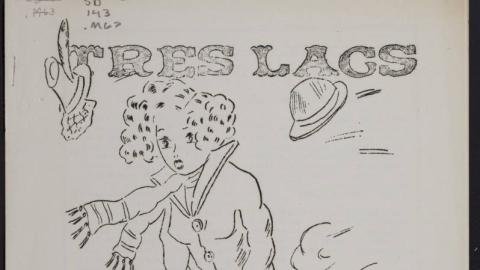
Discussion Questions & Activities
- Notice the early bookmobiles had the book shelves facing outward, while the later bookmobiles had interior shelves and were large enough for patrons to go inside. What would be the advantages of a bookmobile with the shelving facing to the outside? What would be the advantages of a bookmobile with shelving on the inside? How else have the bookmobile vehicles changed over the years?
- Look at the pictures of the interiors of the bookmobile. How do they compare to your local school or public library? How are they different?
- On page 5 of the Script III, Fact Finders Radio Program there is a desciption of the traveling library service available in the state in 1938. What was happening in U.S. history in 1938 that would affect library services? How would a traveling library service fulfill the public needs for library services at that time?
- Examine the photographs of the bookmobiles through the decades. What types of people are using the bookmobile service? Why do you think they are using the bookmobile rather than going to a traditional library building?
- The Stearns County Library Bookmobile has a slogan on the side that says "Education, Information, Recreation." What does that slogan tell you about the types of materials or service a patron could find in the bookmobile?
- In Tres Lacs, March 1939, the Newsletter of a Civilian Conservation Corp camp in Rochert, Minnesota, a partial booklist for a traveling library is included on page 5. Look at this list and compare it to the Travelling Library Number 2 booklist. What do these book lists tell you about the types of audiences using these traveling libraries?
- While bookmobiles still serve many communities in Minnesota, libraries have other means to get library materials to patrons. Many libraries offer interlibrary loan services, where materials are borrowed from library systems across the state or country and delivered to a patron's home library. Library patrons also have access to digital resources such as online articles, ebooks and digital collections like Minnesota Reflections. Patrons can access these digital resources from any place with an internet connection. What advantages and disadvantages do you see for digital materials over mobile library services such as bookmobiles, traveling libraries or interlibrary loan which deliver physical library materials directly to patrons?
- Imagine your community has no library nearby. What kind of a traveling library would you like to see delivered to your neighborhood? Assuming your traveling library must fit inside one box, create a book list. Think about the types of books and materials that would be of local interest and would appeal to many people in your community. Consider any specific needs that people in your community might have when borrowing library materials. Create a list of some specific titles or the types of materials you would like to include in your traveling library.
- Design a bookmobile for your community. Consider how patrons would access the collection and the types of locations the collection would visit. What would be the ideal size and type of vehicle for your mobile library? How would you make the best possible use of resources? How would your mobile library be funded?
eLibrary Minnesota Resources (for Minnesota residents)
Acerro, Heather. "Shifting Gears . . . It's How We Roll." Children & Libraries: The Journal Of The Association For Library Service To Children 14.2 (2016): 8-11. Academic Search Premier. Web. 6 Jan. 2017.
"Bookmobile." Britannica Library, Encyclopædia Britannica, 19 Sep. 2016. Web. Accessed 6 Jan. 2017.
Hyatt, Jason, and Angela Craig. "Adapt For Outreach: Taking Technology On The Road." Computers In Libraries 29.9 (2009): 35. MasterFILE Premier. Web. 6 Jan. 2017.
Magnuson, Peter. "Bringing Books To The People." Parks & Recreation 48.10 (2013): 20. MasterFILE Premier. Web. 6 Jan. 2017.
Additional Resources for Research
Amundsen, John. "Bookmobiles: A Proud History, a Promising Future." American Libraries, 11 Apr. 2012. Web. Accessed 18 Jan. 2017.
"Bookmobile History." St. Paul Public Library, 2017. Web. 09 Jan. 2017.
Brady, Hillary and Franky Abbott. "A History of US Public Libraries." Digital Public Library of America. September 2015. http://dp.la/exhibitions/exhibits/show/history-us-public-libraries/libraries-on-the-move. Accessed 09 Jan. 2017
Geenwald, Jeff. "Long Overdue, the Bookmobile is Back." Smithsonian.com, 23 Feb. 2011. Web. Accessed 09 Jan. 2017.
Huber, Molly. "Traveling Libraries." MNopedia, Minnesota Historical Society. http://www.mnopedia.org/thing/traveling-libraries. Accessed 06 Jan. 2017.
Institute of Museum and Library Services. "Main Libraries, Branches and Bookmobiles: FY 2014 Public Libraries Survey (Outlet Data)." Web. Accessed 18 Jan. 2017.
Pejsa, Jane. Gratia Countryman: Her Life, Her Loves and Her Library. Minneapolis: Nodin Press, 1995.
Ruurs, Margriet. My Librarian Is A Camel: How Books Are Brought to Children Around the World. Honesdale, Pa. : Boyds Mills Press, 2005.
Warburton, Bob. "Delivering the Library." Library Journal, 26 Sep. 2013. Web. Accessed 18 Jan. 2017.
Published onLast Updated on
